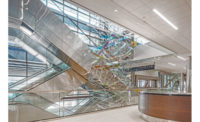Denver-based general contractor Shaw Construction is coming off the biggest year in its 58-year history. Founded by George Shaw in 1962, the firm cut its teeth on projects in Colorado’s mountain towns, building a reputation for multifamily, commercial, municipal and education facilities, along with high-end custom homes.
Today, the midsize builder’s 250 employees are spread across offices in Denver and Grand Junction, Colo., Jackson, Wyo., and Salt Lake City. Shaw has methodically helped to shape the faces of Telluride, Aspen, Vail and Jackson Hole, and its diverse project portfolio includes a balance of multimillion-dollar homes, community-focused work and affordable housing.
“When I came to work for George in 1983, we were a hard-bid industry, performing primarily design-bid-build projects,” says Steve Meyer, Shaw’s CEO since 1988. “But George wanted to be a more collaborative contractor, working in partnership with our owners.
“Today, much of the construction industry has embraced this concept, but that collaboration piece has and continues to be a huge driver of our culture,” Meyer says. “When negotiating our projects, we put the owner’s interest first, but at the same time being fair to our subcontractors and material suppliers as they are our business partners. We can’t be successful unless they’re successful.”
“We believe strong relationships can build great projects,” adds Pat Higgins, president of Shaw’s Front Range operations. Higgins and Meyer’s son, Sam, who is president of Shaw’s Western Slope office, are poised to carry the firm through its third generation of leadership.
“As you come to work for Shaw, you work your way into a leadership position, buy into its culture and belief,” Steve Meyer says.
Mountain Muscle
Shaw’s collaborative spirit, combined with its ability to adapt to the peaks and valleys of the economy, has served the contractor well. The elder Meyer opened Shaw’s Western Slope office in Grand Junction in 1983. It’s currently home base for 50 to 60 employees responsible for approximately 45% of the company’s projects.
Shaw has a long history with Aspen Ski Co. and has built a large number of projects with the Aspen Institute over the last 30 years. Twenty years ago, Shaw built the Sun Deck, perched atop Aspen Mountain at 13,000 ft—and today the contractor is renovating elements of that project, which is accessible only by gondola, snow cat or ATVs.
“By negotiating our projects, we put the owner’s interest first.”
– Steve Meyer, CEO, Shaw Construction
Shaw also has worked with the Grand Junction Housing Authority for 30 years, providing affordable housing, a much-needed resource for the area. “We don’t just cherry pick jobs,” Steve Meyer says. “We’ve been part of the Aspen, Vail and Telluride communities and build what they need in many ways, giving back to them and being involved.”
Some of those projects include the Aspen and Montrose police departments, the Gunnison airport and Fruita Elementary School. The contractor is currently building Aspen City Hall, a three-story concrete and steel multi-department municipal building. The building will consolidate municipal services in downtown Aspen, making services more accessible to the public. The four-year, $18.7-million project will open to the public in early 2021.
Shaw has also built nearly 20 buildings for Colorado Mesa University (formerly Mesa State College) in Grand Junction, helping to make it one of the fastest-growing universities in the West. CMU has become a big economic driver for Grand Junction and the Western Slope.
The $5-million Pathways Family Shelter, which opened in Grand Junction last April, nearly doubles the number of emergency shelter beds in Mesa County. This three-story, 150-bed, state-of-the-art facility houses single women and families, along with a Family Wellness Center staffed through a partnership between Homeward Bound, Marillac Health and CMU’s School of Nursing. The first newly constructed and fully trauma-informed designed facility in the Western U.S., the shelter also includes additional sober-living support programs and significant space for quarantine, should a community need arise.
Shifting Its Weight
While Shaw was making a name for itself building iconic resort properties like Vail’s Arrabelle and Austria Haus as well as the St. Regis and Grand Hyatt hotels in Aspen, its Denver office was doing a lot of wood-frame and residential work. It also became a HUD-approved builder. When the Great Recession hit in 2008, work in the resorts dried up for several years, and that’s when Shaw’s multifamily work in Denver really took off.
“We’re very fortunate to be a leader in the multifamily market; it’s not the sexiest thing to do, but there’s always a need, in good times and bad,” Steve Meyer says. “After the recession, homebuilders weren’t building and multifamily [construction] grew—whether for housing authorities, low-income, market rate, high-end or seniors and assisted care.”
Today, two-thirds of the company’s workforce is located in Denver, and Front Range work accounted for nearly $300 million in revenue last year.
Multifamily projects currently being built by Shaw in the Denver metro area include The Ridge at Pinehurst, a $93.5-million senior-living community in Lakewood featuring assisted-living, memory-care and independent-living facilities; the $58.8-million Millennium/Colorado Station in Denver; the $56.2-million, four-level Brickhouse at Lamar Station; and Iliff Station in Aurora, a $55.7-million, 444,625-sq-ft, Texas wrap-style multifamily project with 316 units and two separate buildings connected by a pedestrian bridge.
Innovative Delivery
“Shaw has become very innovative in their project delivery methods, which for me as a developer helps take some of the risk out of the construction process,” says Chris LaPlante of Jensen LaPlante Development. A multifamily housing developer in Fort Collins, Jensen LaPlante is starting its 10th project with Shaw in the last 15 years.
Shaw began self-performing its own framing and concrete work six years ago and now has its own wood-panel production facility in Denver. “Eighty percent of wood frame is done by us, and we do 70% of our own concrete,” Higgins says. “This brings a huge value to the customer and has allowed us to step up our volume and take on a lot of larger projects.”
LaPlante adds: “This offsite fabrication is an opportunity to provide more certainty in a controlled environment. Fabricating wall panels and bringing them to the site in a sequence really accelerates the project. For me that’s one of the advantages of using Shaw.”
The contractor recently completed the Union Pointe apartments in Longmont and the Wyatt Apartments in Fort Collins, both with Jensen LaPlante, and is currently constructing View 21 in Colorado Springs.
Late last year, Shaw invested in a modular apartment factory with a builder in North Carolina. Shaw’s self-performing group will help install the modular units, bringing a fully integrated, turnkey option to its multifamily clients. Shaw is currently building a couple of modular projects in mountain areas where labor is scarce and construction costs are high. “Modular brings consistency and quality,” Higgins says. “What we’re selling is schedule—it can be built faster than stick.”
In addition to building Colorado’s first LEED-certified project atop Aspen Mountain, Shaw has also collaborated on numerous green projects, including Burlingame Affordable Housing, which is currently undergoing a 10-year study by the National Renewable Energy Lab for its cold-climate techniques.
Teton County
Shaw’s Jackson, Wyo., office opened in 2002, and the contractor rapidly grew to become one of the largest multifamily builders in the area. It accounts for approximately 10% of the company’s volume.
“Many projects that were our anchor in 2019 were wrapping up [when the pandemic hit],” says Chase Beninga, managing partner at Shaw. The $48-million Hidden Hollow Townhomes in Jackson Hole was just turned over to the owner in July. With 140 units, the project is considered a rarity for the area.
“Most municipalities and states kept construction going as an essential business, especially for housing projects,” Beninga says. “We never had a lull; we had our foot on the gas the whole time.”
Shaw recently completed a 13,500-sq-ft vertical greenhouse on the facade of a downtown Jackson parking garage. Up next, Shaw is breaking ground on 20 high-end condos in downtown Jackson and a $16-million single-family home is scheduled to finish by the end of year.
“We’ve seen a number of projects being pushed or put on hold indefinitely as individuals are trying to figure out the financing and sense of comfort with an election year,” Sam Meyer says.
But owners are still coming with projects. As people leave Denver and other large cities, they are buying up properties in mountain resort communities, which creates potential for future opportunities, Steve Meyer says. “I’m not sure how long that bubble can go on. Developers tend to overbuild, but there’s a lot of demand, and baby boomers will be a huge driver over the next 10 to 20 years,” he says.








Post a comment to this article
Report Abusive Comment